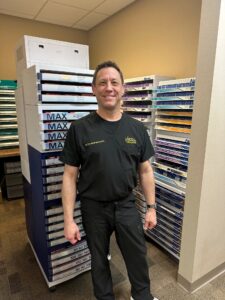
Dr. Bedinghaus in his office’s contact-lens supply room.Dr. Bedinghaus says that with the right patient education and interactions, many more patients can be turned into dual wearers of both contact lenses and glasses.
By Troy Bedinghaus, OD
May 3, 2023
You have a huge opportunity to make more patients regular dual wearers of both contact lenses and glasses. A recent study by Contact Lens Institute (CLI) highlights this opportunity.
While only one-in-four (23.6 percent) adults reported using both contact lenses and glasses, there’s considerable interest in dual wear among the remaining population. Almost one-in-five glasses-only wearers are very interested in contact lenses (18 percent), and the same percentage of contact lens-only wearers are very interested in glasses. In total, this represents an unrealized prescribing opportunity for more than one-third of all patients.
Here is how my team and I have gotten around 35 percent of our patients to be both regular contact lens and glasses wearers.
Presume the Patient Needs & Wants Both CLs & Glasses
Instead of asking patients or telling them that they need both, I simply say, “Would you feel safe if something happened to your contact lenses, say when traveling? Could you function?” Also, I reinforce that contact-lens technology has never been better, but it is still a piece of plastic, a foreign body in your eye. Love your eyes! Wear glasses part-time.
Adding contact lenses to normal eyeglass wearing habits is usually not a huge concern monetarily. Adding glasses to a patient’s normal contact-lens wear is more commonly an expense concern. So, we offer a creative way to pay for their glasses, such as using a 90-day payment plan offered by Sunbit, or six months financing through CareCredit.
Alternatively, we can use a subscription model to spread their contact lens purchase out to make both more affordable.
Another way to offer both is to tell patients that your staff will calculate their insurance “contribution” to “maximize their savings,” so that both contact lenses and glasses can be purchased. Keywords are crucial.
I teach my staff to always “assume the sale.” You don’t have to worry, the patient will tell you if they don’t want to proceed. But assume they are there to purchase their eyewear AND their contact lenses.
Sometimes patients just didn’t think about it! You must ask them for the sale.
Occasionally, we place contact lenses on patients who don’t usually wear contact lenses to enable them to choose their frame easier. Almost every time we place contact lenses on a patient they decide they would like a proper contact-lens evaluation…they simply didn’t think it would be that easy. They want both glasses and the option of wearing contacts!
Other Articles to Explore
Ask Patients in Pretesting About CLs
We ask the patient in the pretesting stage of our exam if they are planning to purchase (or interested in trying) contact lenses and glasses today? I find it astonishing that some practices are afraid to ask the patient if they are planning to do this during their visit. This is a big part of what we do. Treat it with respect. The patient’s response is not always definitive, but at the very least, if they check YES, we would really be doing a disservice if the patient left without getting that accomplished! Another approach is to ask, “What are your goals for today?” This is an open-ended question that brings up all kinds of opportunities.
Ask Patients What They Did & Didn’t About Last Glasses
It’s better to ask what patients did and didn’t like about their old glasses than focusing on whether or not they are going to purchase them. We assume that they will get glasses that day, just as they will get contact lenses.
Alternately, even though they showed no interest in getting glasses too, ask them, “What features would you like on your new glasses?” It creates conversation about their glasses. The patient may not have even thought about getting new glasses, but is excited about the opportunity.
Furthermore, a doctor who asks about both glasses and contact lenses can be confident about their recommendations. For example, you might say: “OK, Mrs. Smith, I have finalized your contact-lens prescription. Also, I am prescribing a lens for your new glasses that is going to make you see better, look better and feel better!”
If you don’t bring up both glasses and contact lenses, nothing will happen. It is a law of averages. The more people you bring the option for both glasses and contact lenses up to, the more who will say yes.
Train Opticians to Ask Patients About CLs
When a patient complains of things like their glasses slipping down their nose, or the irritation of wearing glasses doing activities that require masks like scuba diving, we teach opticians to say things like, “Is there a reason why you have not tried contact lenses before?” Or: “Just because we develop a great contact-lens prescription does not mean you have to wear them every day…but wow, wouldn’t it be great to have the luxury of choosing every day?!”
If a newfound desire for contact lenses is revealed, we immediately have the optician bring the patient back while they are still in the office that day. Any extra consent forms are available to sign immediately within our EHR. With the advent of wonderfully comfortable materials there is no reason to delay. If they do not have time, we tell them, “If you decide you still want us to perform a contact-lens evaluation, you come can come back in within 90 days and we will charge you for a contact-lens evaluation only instead of the entire examination.” Make it easy!
Some doctors are concerned about time. But how long does it really take? Think of it this way, some patients would pay MORE if it were faster! With the exception of specialty contact lenses, a contact-lens evaluation does not need to be a long, drawn-out, complicated ordeal.
Educate Patients on How Different Today’s Contact Lenses Are
Patients who only experienced contact lenses years ago may not realize there are now many lens options that are vastly more comfortable. I keep it simple and say, “Three things have changed dramatically in contact lenses since you may have tried them before. 1) The materials have dramatically improved to balance both wettability and oxygen transmission. We have lenses that are frictionless now! 2) It’s easier to wear them. With daily disposables, whether you wear them for one hour or 10 hours, you simply toss the lens in the trash can after use! 3) We are getting to the point that astigmatic presbyopia blue-light correcting lenses are available now, so it’s rare for anyone not to be able to comfortably wear contact lenses.
I ask the patient if they would like a lens they never have to clean? We present daily disposables as the only option. Some of our patients don’t even know there are monthly or reusable lenses. Also, some patients get it in their head that just because we fit them with contact lenses that they must wear them full-time. I let them know that part-time wear is perfectly fine.
Occasionally, patients will say, “Oh I chose a monthly lens because I don’t wear them that much and it’s more cost effective.” I reeducate them on the fact that actually, it’s much more cost effective to purchase one 90 pack per eye, no solution purchases and much healthier to wear a brand new lens.
Often, patients want daily disposables as an option because they only wear them for sports or maybe for giving presentations at work. Having the option of wearing glasses and contact lenses whenever they choose is hard for most patients to say no to.
 Troy Bedinghaus, OD, is the owner of Vision Source-Lakewood Ranch and Vision Source – Parrish in Florida. To contact him: tbedinghaus@visionsource.com
Troy Bedinghaus, OD, is the owner of Vision Source-Lakewood Ranch and Vision Source – Parrish in Florida. To contact him: tbedinghaus@visionsource.com

























